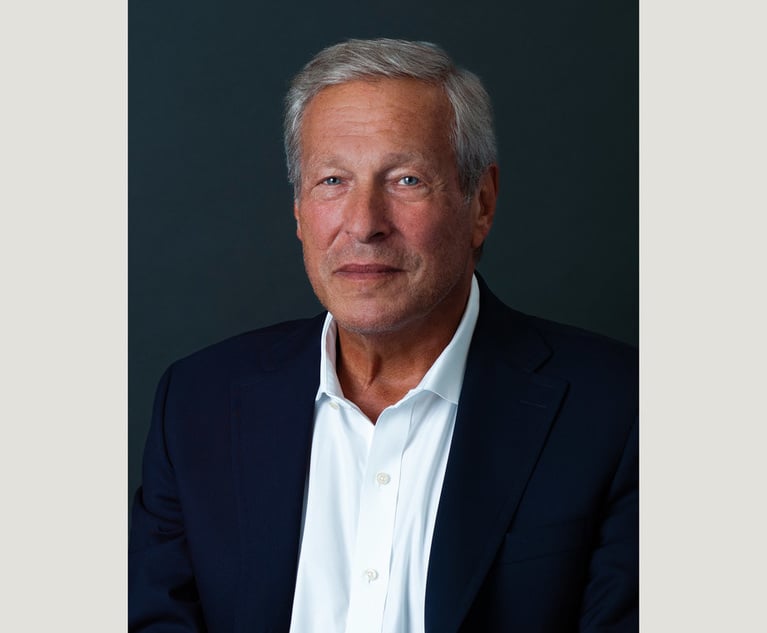Proposition 65 After 40 Years: Public Benefit or Enrichment for a Few?
Although the law has helped reduce the amount of harmful chemicals in some consumer products, in most cases there has been no meaningful benefit. At the same time it has generated a cottage industry of citizen plaintiffs and attorneys.
December 22, 2017 at 12:00 AM
7 minute read

Long the subject of controversy since it became law 40 years ago, the California Safe Drinking Water and Toxic Enforcement Act of 1986, more commonly known as Proposition 65, has become of staple of California's legal, and consumer products, landscape. What was originally intended to ensure that unsafe chemicals were not present in drinking water, and to provide consumers with information to allow for informed purchasing decisions, has over the years been transformed into something very different. Instead, the ubiquitous Proposition 65 warning label, seen in stores, gas stations, parking garages and on tool sets, for example, is virtually ignored by many California consumers. Although the law has succeeded in reducing the amount of some harmful chemicals in certain consumer products, such as lead, in most cases there has been no meaningful benefit. Instead, it has generated a cottage industry of citizen plaintiffs and attorneys, some of whom have been enriched by manipulating the statute to their advantage.
For example, in one case that is currently being tried in Los Angeles Superior Court, Council for Education and Research on Toxics (CERT) v. Starbucks, CERT alleges that coffee retailers and roasters need to provide a Proposition 65 warning for exposure to acrylamide when drinking coffee. Acrylamide is widespread and has been in food since the advent of fire, present in trace amounts in roasted and baked products, such as coffee, bread, potatoes, cereal, chips and the like, simply because when these foods are prepared, the baking process results in a chemical reaction that produces low levels of acrylamide. Although in industrial settings acrylamide has been found at high levels that could affect workers' health, levels in consumer food products are negligible.
Under Proposition 65, a warning is required if exposure to acrylamide exceeds a “no significant risk level.” For acrylamide, the “no significant risk level” has been set at 0.5 micrograms per day. However, in reality, and depending on which scientist you talk to, that level should more appropriately be set at a level of at least 1.0 micrograms per day, and perhaps as high as 20 micrograms or more per day. In other words, there does not appear to be any real health risk to coffee drinkers, cereal eaters or pretzel addicts! Yet, if CERT prevails in this case, its lawyers stand to gain millions of dollars, all for the benefit of posting a warning sign at your local coffee shop for a risk that is highly questionable.
The California attorney general has primary authority to enforce Proposition 65. However, the cases the attorney general will get involved in are few and far between. Rather, the vast bulk of Proposition 65 cases are brought by citizen enforcers on behalf of the public, essentially standing in the shoes of the attorney general. (Similar to many state and federal environmental and consumer statutes, if the government is not diligently enforcing the law, Proposition 65 permits enforcement through these “citizen suits.”)
Whereas most laws place a significant burden on a plaintiff to prove its case, Proposition 65 is different. For the most part, all the Proposition 65 plaintiff needs to show is that the defendant has 10 or more employees, a chemical listed under Proposition 65 is present in the product, and a consumer or user of the product would be exposed to that chemical. The burden then shifts to the defendant to disprove those elements or, more commonly, to show that even if the chemical is present, and a consumer or user is exposed to the chemical, the exposure to the chemical is not at a level that triggers the warning requirement (for example, the “no significant risk level” for acrylamide). In most instances, actual exposure is below that triggering level, but because it is very expensive to provide the evidence necessary to make such a showing at a trial (both legal fees and technical expert costs), most Proposition 65 defendants simply pay a small penalty, and large attorney fees to the plaintiff, to be done with it and move on.
Indeed, there is another strong incentive for the defendant to settle the case with the private plaintiff. Although the plaintiff, if it wins the case, will in most cases be entitled to recover its attorney fees and costs, a prevailing defendant cannot do so. That is because courts have interpreted Proposition 65 enforcement to confer a significant benefit to the public, and therefore to be eligible for attorney fee recovery under section 1021.5 of the Code of Civil Procedure. However, a prevailing defendant is not so fortunate, and after spending perhaps hundreds of thousands to dollars to successfully defend the lawsuit, recovers nothing. Therefore, even if the defendant wins, it loses!
Of course, where the matter can significantly impact a company or an industry—such as the acrylamide in coffee case or other cases seeking to require warning labels on other food products such as snack foods or candy, or other significant industry-wide matters, such as flame retardants in furniture or mercury in seafood—challenging the allegations rather than quickly settling may be in the defendant's interest. But that is not the typical situation. For example, a manufacturer of booster cables or lug wrenches will likely not be too concerned that there will be a decrease in sales in California if a Proposition 65 warning label is on its product.
There have been efforts to address this problem. Indeed, Governor Brown, in proposing a series of Proposition 65 reforms a few years ago, referred to Proposition 65 citizen plaintiffs' actions as “shakedown” lawsuits. Legislation to address this problem has also been proposed over the years, but by the time a proposed reform makes its way through the various legislative committees, it is so diluted that it only nibbles around the edges of the problem. The attorney general has also instituted policies that attempt to make honest brokers out of these citizen enforcers, but those, too, have only had limited impact.
One recent effort looked to settlements that went into the pockets of some of the plaintiffs' groups. The monetary portion of the settlement has three elements: under the statute, 75 percent of the penalty goes to the state, and 25 percent of the penalty goes to the named plaintiff, and there is a significant attorney fee payment that dwarfs the penalty payment. Many plaintiffs' groups allege that they are bona fide environmental or consumer protection organizations, and add a fourth payment to any settlement demand—an “in-lieu-of-penalty” payment, where most of the penalty ends up going to the plaintiff rather than the state. Certainly, there are reputable groups out there that take seriously their responsibility as private enforcers acting on behalf of the citizens of California, and use those funds to legitimately further their respective missions. Less can be said of some others. To address this problem, the attorney general issued regulations that would limit the amount of in-lieu-of-penalty payments that go directly to the plaintiff (in addition to the attorney fees that the plaintiff's lawyer receives), or otherwise make it more difficult to settle a case out of court where money goes directly to the plaintiff's pocket. Although this has had some impact on weeding out the less-reputable players, it barely scratches the surface.
Given this experience over the past 40 years, the legislature, the governor and the attorney general are well aware of the problems that have arisen from this well-intentioned yet troubled statute. Moreover, courts are bound to rule within the parameters of the statute, regardless of the opportunity for permissive abuse that is inherent in the law. However, there are limits to the extent the legislature can reform a voter-enacted initiative, and California politics do not easily lend themselves to be seen as retracting something viewed as a consumer-protection law. Simply put, Proposition 65, with all of its warts, is here to stay and is not going anywhere.
Joshua Bloom is a principal at Meyers Nave Riback Silver & Wilson, in Oakland. He practices in the firm's Land Use and Environmental Law Practice Groups, focusing on state and federal environmental and natural resources law, including complex environmental litigation, brownfields, environmental aspects of transactional matters, and compliance counseling, representing both public and private clients.
This content has been archived. It is available through our partners, LexisNexis® and Bloomberg Law.
To view this content, please continue to their sites.
Not a Lexis Subscriber?
Subscribe Now
Not a Bloomberg Law Subscriber?
Subscribe Now
NOT FOR REPRINT
© 2025 ALM Global, LLC, All Rights Reserved. Request academic re-use from www.copyright.com. All other uses, submit a request to [email protected]. For more information visit Asset & Logo Licensing.
You Might Like
View All


Trending Stories
Who Got The Work
J. Brugh Lower of Gibbons has entered an appearance for industrial equipment supplier Devco Corporation in a pending trademark infringement lawsuit. The suit, accusing the defendant of selling knock-off Graco products, was filed Dec. 18 in New Jersey District Court by Rivkin Radler on behalf of Graco Inc. and Graco Minnesota. The case, assigned to U.S. District Judge Zahid N. Quraishi, is 3:24-cv-11294, Graco Inc. et al v. Devco Corporation.
Who Got The Work
Rebecca Maller-Stein and Kent A. Yalowitz of Arnold & Porter Kaye Scholer have entered their appearances for Hanaco Venture Capital and its executives, Lior Prosor and David Frankel, in a pending securities lawsuit. The action, filed on Dec. 24 in New York Southern District Court by Zell, Aron & Co. on behalf of Goldeneye Advisors, accuses the defendants of negligently and fraudulently managing the plaintiff's $1 million investment. The case, assigned to U.S. District Judge Vernon S. Broderick, is 1:24-cv-09918, Goldeneye Advisors, LLC v. Hanaco Venture Capital, Ltd. et al.
Who Got The Work
Attorneys from A&O Shearman has stepped in as defense counsel for Toronto-Dominion Bank and other defendants in a pending securities class action. The suit, filed Dec. 11 in New York Southern District Court by Bleichmar Fonti & Auld, accuses the defendants of concealing the bank's 'pervasive' deficiencies in regards to its compliance with the Bank Secrecy Act and the quality of its anti-money laundering controls. The case, assigned to U.S. District Judge Arun Subramanian, is 1:24-cv-09445, Gonzalez v. The Toronto-Dominion Bank et al.
Who Got The Work
Crown Castle International, a Pennsylvania company providing shared communications infrastructure, has turned to Luke D. Wolf of Gordon Rees Scully Mansukhani to fend off a pending breach-of-contract lawsuit. The court action, filed Nov. 25 in Michigan Eastern District Court by Hooper Hathaway PC on behalf of The Town Residences LLC, accuses Crown Castle of failing to transfer approximately $30,000 in utility payments from T-Mobile in breach of a roof-top lease and assignment agreement. The case, assigned to U.S. District Judge Susan K. Declercq, is 2:24-cv-13131, The Town Residences LLC v. T-Mobile US, Inc. et al.
Who Got The Work
Wilfred P. Coronato and Daniel M. Schwartz of McCarter & English have stepped in as defense counsel to Electrolux Home Products Inc. in a pending product liability lawsuit. The court action, filed Nov. 26 in New York Eastern District Court by Poulos Lopiccolo PC and Nagel Rice LLP on behalf of David Stern, alleges that the defendant's refrigerators’ drawers and shelving repeatedly break and fall apart within months after purchase. The case, assigned to U.S. District Judge Joan M. Azrack, is 2:24-cv-08204, Stern v. Electrolux Home Products, Inc.
Featured Firms
Law Offices of Gary Martin Hays & Associates, P.C.
(470) 294-1674
Law Offices of Mark E. Salomone
(857) 444-6468
Smith & Hassler
(713) 739-1250







